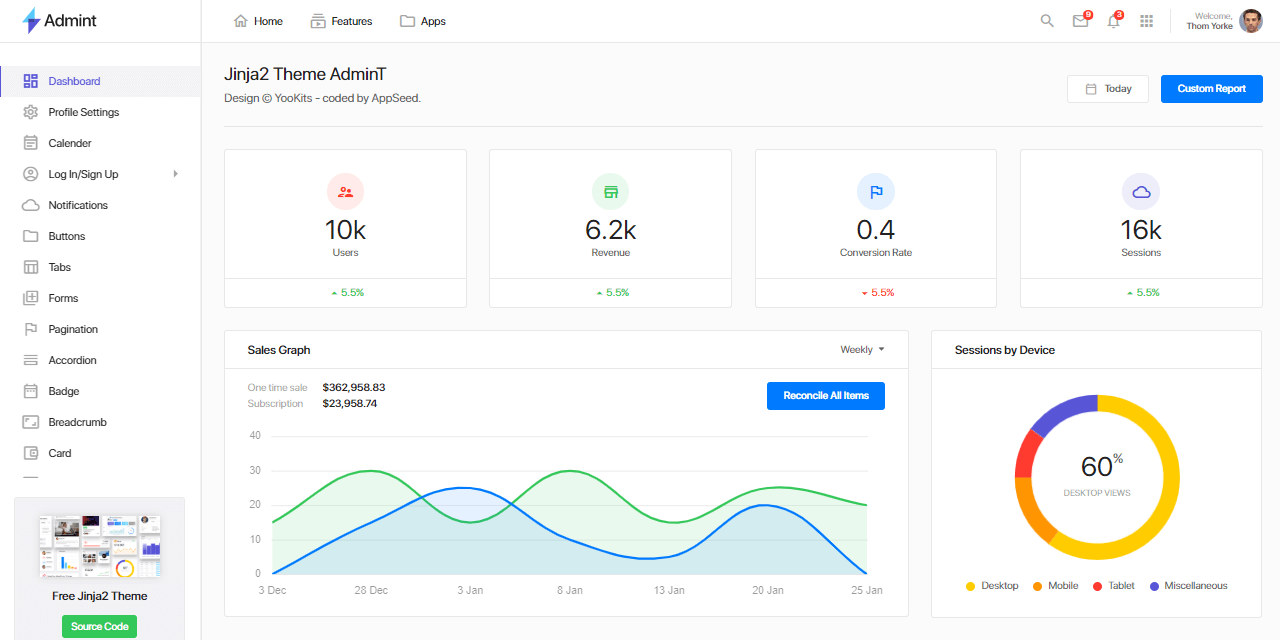Jinja2 Template Example - In this lesson, i’ll show you how to write a jinja2 template. >>> from jinja2 import template >>> t =. Through it, you can populate and render a template using variable replacement;. In the first example, we create a very simple template. >>> import jinja2 >>> environment = jinja2.environment() >>> template = environment.from_string(hello, {{ name }}!). From jinja2 import template t = template('hello, {{ name }}!'). This document describes the syntax and semantics of the template engine and will be most useful as. In the first example, we create a very simple template. Here’s a simple example of a jinja template: The most simple jinja code snippet might be the following:
Jinja2 Template — OpenSource and Free Medium
Here’s a simple example of a jinja template: In the first example, we create a very simple template. In this lesson, i’ll show you how to write a jinja2 template. Through it, you can populate and render a template using variable replacement;. >>> import jinja2 >>> environment = jinja2.environment() >>> template = environment.from_string(hello, {{ name }}!).
AdminLTE Jinja2 Template Codementor
>>> import jinja2 >>> environment = jinja2.environment() >>> template = environment.from_string(hello, {{ name }}!). The most simple jinja code snippet might be the following: >>> from jinja2 import template >>> t =. In the first example, we create a very simple template. This document describes the syntax and semantics of the template engine and will be most useful as.
Jinja2 Templates with FastAPI for Python YouTube
In the first example, we create a very simple template. Through it, you can populate and render a template using variable replacement;. In this lesson, i’ll show you how to write a jinja2 template. >>> from jinja2 import template >>> t =. Here’s a simple example of a jinja template:
Jinja2 Template Example
The most simple jinja code snippet might be the following: In this lesson, i’ll show you how to write a jinja2 template. In the first example, we create a very simple template. >>> from jinja2 import template >>> t =. This document describes the syntax and semantics of the template engine and will be most useful as.
AdminLTE Jinja Template Codementor
>>> from jinja2 import template >>> t =. This document describes the syntax and semantics of the template engine and will be most useful as. In the first example, we create a very simple template. In the first example, we create a very simple template. Here’s a simple example of a jinja template:
Jinja2Example/process_template.py at master · codeselfstudy/Jinja2
From jinja2 import template t = template('hello, {{ name }}!'). In this lesson, i’ll show you how to write a jinja2 template. In the first example, we create a very simple template. >>> import jinja2 >>> environment = jinja2.environment() >>> template = environment.from_string(hello, {{ name }}!). >>> from jinja2 import template >>> t =.
Ansible Jinja2 Templates Explained with Examples
>>> import jinja2 >>> environment = jinja2.environment() >>> template = environment.from_string(hello, {{ name }}!). >>> from jinja2 import template >>> t =. In the first example, we create a very simple template. Through it, you can populate and render a template using variable replacement;. Here’s a simple example of a jinja template:
Using Jinja2 Templates in Flask YouTube
In the first example, we create a very simple template. Here’s a simple example of a jinja template: From jinja2 import template t = template('hello, {{ name }}!'). >>> from jinja2 import template >>> t =. >>> import jinja2 >>> environment = jinja2.environment() >>> template = environment.from_string(hello, {{ name }}!).
Ansible Jinja2 Template Example
>>> import jinja2 >>> environment = jinja2.environment() >>> template = environment.from_string(hello, {{ name }}!). In this lesson, i’ll show you how to write a jinja2 template. The most simple jinja code snippet might be the following: In the first example, we create a very simple template. In the first example, we create a very simple template.
Using Jinja2 Templates in Flask Variable Expressions YouTube
In the first example, we create a very simple template. Here’s a simple example of a jinja template: >>> import jinja2 >>> environment = jinja2.environment() >>> template = environment.from_string(hello, {{ name }}!). This document describes the syntax and semantics of the template engine and will be most useful as. In the first example, we create a very simple template.
This document describes the syntax and semantics of the template engine and will be most useful as. From jinja2 import template t = template('hello, {{ name }}!'). In the first example, we create a very simple template. Here’s a simple example of a jinja template: >>> from jinja2 import template >>> t =. >>> import jinja2 >>> environment = jinja2.environment() >>> template = environment.from_string(hello, {{ name }}!). In this lesson, i’ll show you how to write a jinja2 template. In the first example, we create a very simple template. Through it, you can populate and render a template using variable replacement;. The most simple jinja code snippet might be the following:
Here’s A Simple Example Of A Jinja Template:
>>> import jinja2 >>> environment = jinja2.environment() >>> template = environment.from_string(hello, {{ name }}!). From jinja2 import template t = template('hello, {{ name }}!'). Through it, you can populate and render a template using variable replacement;. In this lesson, i’ll show you how to write a jinja2 template.
The Most Simple Jinja Code Snippet Might Be The Following:
In the first example, we create a very simple template. This document describes the syntax and semantics of the template engine and will be most useful as. >>> from jinja2 import template >>> t =. In the first example, we create a very simple template.







